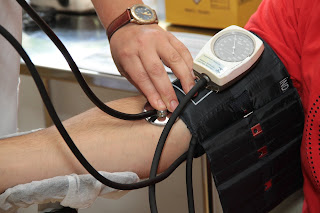Hypertension Causes Symptoms Prevention and History
Hypertension (HTN or HT), also is called high blood pressure (HBP). Hypertension increases blood pressure in the arteries. Due to this increase in pressure, the heart needs to work more than normal to maintain blood flow to the arteries of the blood. Hypertension consists of two measurements, systolic and diastolic, Which depends on the fact that the systolic is occurring in the heart muscles or is being diastolic in between the beats. At rest, normal blood pressure is within the range of 100-140 mmHg systolic (highest-reading) and 60-90 mmHg diastolic (low-reading). Hypertension is present if it remains constant at or above 90/140 mmHg.Hypertension is classified as primary high blood pressure and secondary high blood pressure. 90-95% of cases are classified as "primary hypertension"
If you have Hypertension, this high pressure puts extra stress on your heart and blood arteries. Over time, this excess stress enhances the risk of your heart attack or stroke. Complications of high blood pressure include cardiovascular disease, kidney disease, hardening of arteries, eye damage, and stroke (brain damage).
Symptoms Of Hypertension
Most people with high blood pressure (HBP) will not experience any symptoms unless the level is high up to 180/110 mmHg.Symptoms of Hypertension include:
- A headache, usually for several days
- Nausea
- Vomit
- Dizziness - Volatility and Vertigo
- Diplopia
- Bleeding nose
- Nervousness
- Dyspnea
If any people experience these symptoms, they should immediately see their doctor. If long-term treatment is left untreated, high blood pressure can lead to the following complications:- Heart attack, stroke, heart failure.
Hypertension Prevention
Many people suffer from hypertension, but they do not realize it. There is a need to focus on measures to reduce the need for high blood pressure medication therapy. In order to reduce blood pressure, lifestyle changes are recommended before medicines begin treatment. For the Prevention of Hypertension, 2004 guidelines for the British High Blood Pressure Society. Offer the following lifestyle, which is in line with the instructions outlined in 2002 by the National High BP Education Program of America.- Maintain normal body weight (for example, body weight index 20-25 kg / m).
- Limit sodium content in diet to <100 mmol/day (<6 grams of sodium chloride or <2.6 grams of sodium per day).
- Regular use of aerobic physical activity such as fast walking (≥ 30 minutes per day, most days in a week).
- Limit consumption of alcohol, maximum 3 units/day for men and maximum 2 units/day for women.
- Diet including fruits and vegetables more than (eg, at least five portions per day).
Effective lifestyle modification can also reduce blood pressure as much as any anti-blood drug. Combination of two or more lifestyle modifications can also give better results.


Post a Comment